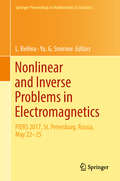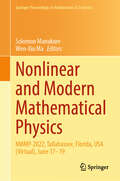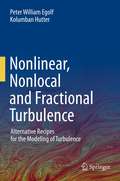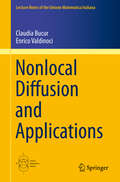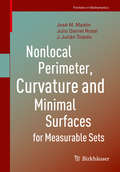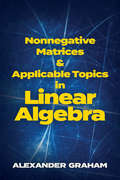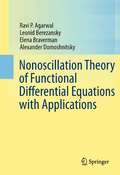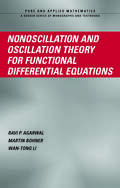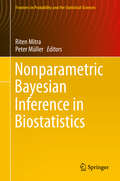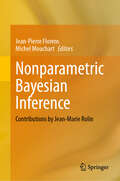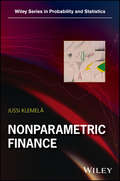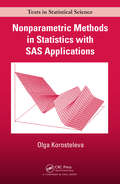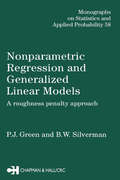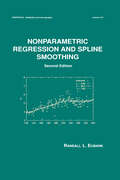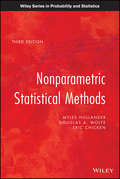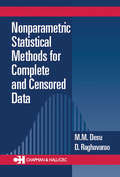- Table View
- List View
Nonlinear and Convex Analysis: Proceedings in Honor of Ky Fan
by Stephen Simons Bor-Luh LinThis book contains expanded versions of the talks given at the conference held in honour of professor Ky Fan in California in 1985, as well as papers on nonlinear and convex analysis as contributions to Ky Fan. It also includes a list of publications by Ky Fan.
Nonlinear and Inverse Problems in Electromagnetics: PIERS 2017, St. Petersburg, Russia, May 22-25 (Springer Proceedings in Mathematics & Statistics #243)
by L. Beilina Yu. G. SmirnovThis volume provides academic discussion on the theory and practice of mathematical analysis of nonlinear and inverse problems in electromagnetics and their applications. From mathematical problem statement to numerical results, the featured articles provide a concise overview of comprehensive approaches to the solution of problems. Articles highlight the most recent research concerning reliable theoretical approaches and numerical techniques and cover a wide range of applications, including acoustics, electromagnetics, optics, medical imaging, and geophysics. The nonlinear and ill-posed nature of inverse problems and the challenges they present when developing new numerical methods are explained, and numerical verification of proposed new methods on simulated and experimental data is provided. Based on the special session of the same name at the 2017 Progress in Electromagnetics Research Symposium, this book offers a platform for interaction between theoretical and practical researchers and between senior and incoming members in the field.
Nonlinear and Modern Mathematical Physics: NMMP-2022, Tallahassee, Florida, USA (Virtual), June 17–19 (Springer Proceedings in Mathematics & Statistics #459)
by Solomon Manukure Wen-Xiu MaThis book gathers peer-reviewed, selected contributions from participants of the 6th International Workshop on Nonlinear and Modern Mathematical Physics (NMMP-2022), hosted virtually from June 17–19, 2022. Works contained in this volume cover topics like nonlinear differential equations, integrable systems, Hamiltonian systems, inverse scattering transform, Painleve's analysis, nonlinear wave phenomena and applications, numerical methods of nonlinear wave equations, quantum integrable systems, and more. In this book, researchers and graduate students in mathematics and related areas will find new methods and tools that only recently have been developed to solve nonlinear problems. The sixth edition of the NMMP workshop was organized by Florida A&M University in Tallahassee, Florida, USA, with support from the University of South Florida, Florida State University, Embry-Riddle Aeronautical University, Savannah State University, Prairie View A&M University, and Beijing Jiaotong University. The aim was to bring together researchers from around the world to present their findings and foster collaboration for future research.
Nonlinear, Nonlocal and Fractional Turbulence: Alternative Recipes for the Modeling of Turbulence
by Kolumban Hutter Peter William EgolfExperts of fluid dynamics agree that turbulence is nonlinear and nonlocal. Because of a direct correspondence, nonlocality also implies fractionality. Fractional dynamics is the physics related to fractal (geometrical) systems and is described by fractional calculus. Up-to-present, numerous criticisms of linear and local theories of turbulence have been published. Nonlinearity has established itself quite well, but so far only a very small number of general nonlocal concepts and no concrete nonlocal turbulent flow solutions were available. This book presents the first analytical and numerical solutions of elementary turbulent flow problems, mainly based on a nonlocal closure. Considerations involve anomalous diffusion (Lévy flights), fractal geometry (fractal-β, bi-fractal and multi-fractal model) and fractional dynamics. Examples include a new ‘law of the wall’ and a generalization of Kraichnan’s energy-enstrophy spectrum that is in harmony with non-extensive and non-equilibrium thermodynamics (Tsallis thermodynamics) and experiments. Furthermore, the presented theories of turbulence reveal critical and cooperative phenomena in analogy with phase transitions in other physical systems, e.g., binary fluids, para-ferromagnetic materials, etc.; the two phases of turbulence identifying the laminar streaks and coherent vorticity-rich structures. This book is intended, apart from fluids specialists, for researchers in physics, as well as applied and numerical mathematics, who would like to acquire knowledge about alternative approaches involved in the analytical and numerical treatment of turbulence.
Nonlinearities in Economics: An Interdisciplinary Approach to Economic Dynamics, Growth and Cycles (Dynamic Modeling and Econometrics in Economics and Finance #29)
by Ruedi Stoop Alexander N. Pisarchik Giuseppe OrlandoThis interdisciplinary book argues that the economy has an underlying non-linear structure and that business cycles are endogenous, which allows a greater explanatory power with respect to the traditional assumption that dynamics are stochastic and shocks are exogenous. The first part of this work is formal-methodological and provides the mathematical background needed for the remainder, while the second part presents the view that signal processing involves construction and deconstruction of information and that the efficacy of this process can be measured. The third part focuses on economics and provides the related background and literature on economic dynamics and the fourth part is devoted to new perspectives in understanding nonlinearities in economic dynamics: growth and cycles. By pursuing this approach, the book seeks to (1) determine whether, and if so where, common features exist, (2) discover some hidden features of economic dynamics, and (3) highlight specific indicators of structural changes in time series. Accordingly, it is a must read for everyone interested in a better understanding of economic dynamics, business cycles, econometrics and complex systems, as well as non-linear dynamics and chaos theory.
Nonlinearity, Complexity and Randomness in Economics: Towards Algorithmic Foundations for Economics (Surveys of Recent Research in Economics #9)
by Stefano Zambelli Donald A.R. GeorgeNonlinearity, Complexity and Randomness in Economics presents a variety of papers by leading economists, scientists, and philosophers who focus on different aspects of nonlinearity, complexity and randomness, and their implications for economics. A theme of the book is that economics should be based on algorithmic, computable mathematical foundations. Features an interdisciplinary collection of papers by economists, scientists, and philosophers Presents new approaches to macroeconomic modelling, agent-based modelling, financial markets, and emergent complexity Reveals how economics today must be based on algorithmic, computable mathematical foundations
Nonlocal Diffusion and Applications
by Claudia Bucur Enrico ValdinociWorking in the fractional Laplace framework, this book provides models and theorems related to nonlocal diffusion phenomena. In addition to a simple probabilistic interpretation, some applications to water waves, crystal dislocations, nonlocal phase transitions, nonlocal minimal surfaces and Schrödinger equations are given. Furthermore, an example of an s-harmonic function, its harmonic extension and some insight into a fractional version of a classical conjecture due to De Giorgi are presented. Although the aim is primarily to gather some introductory material concerning applications of the fractional Laplacian, some of the proofs and results are new. The work is entirely self-contained, and readers who wish to pursue related subjects of interest are invited to consult the rich bibliography for guidance.
Nonlocal Perimeter, Curvature and Minimal Surfaces for Measurable Sets (Frontiers in Mathematics)
by José M. Mazón Julio Daniel Rossi J. Julián ToledoThis book highlights the latest developments in the geometry of measurable sets, presenting them in simple, straightforward terms. It addresses nonlocal notions of perimeter and curvature and studies in detail the minimal surfaces associated with them. These notions of nonlocal perimeter and curvature are defined on the basis of a non-singular kernel. Further, when the kernel is appropriately rescaled, they converge toward the classical perimeter and curvature as the rescaling parameter tends to zero. In this way, the usual notions can be recovered by using the nonlocal ones. In addition, nonlocal heat content is studied and an asymptotic expansion is obtained. Given its scope, the book is intended for undergraduate and graduate students, as well as senior researchers interested in analysis and/or geometry.
Nonlocal and Fractional Operators (SEMA SIMAI Springer Series #26)
by Francesco Mainardi Luisa Beghin Roberto GarrappaThe purpose of this volume is to explore new bridges between different research areas involved in the theory and applications of the fractional calculus. In particular, it collects scientific and original contributions to the development of the theory of nonlocal and fractional operators. Special attention is given to the applications in mathematical physics, as well as in probability. Numerical methods aimed to the solution of problems with fractional differential equations are also treated in the book. The contributions have been presented during the international workshop "Nonlocal and Fractional Operators", held in Sapienza University of Rome, in April 2019, and dedicated to the retirement of Prof. Renato Spigler (University Roma Tre). Therefore we also wish to dedicate this volume to this occasion, in order to celebrate his scientific contributions in the field of numerical analysis and fractional calculus. The book is suitable for mathematicians, physicists and applied scientists interested in the various aspects of fractional calculus.
Nonnegative Matrices and Applicable Topics in Linear Algebra (Dover Books on Mathematics)
by Alexander GrahamNonnegative matrices is an increasingly important subject in economics, control theory, numerical analysis, Markov chains, and other areas. This concise treatment is directed toward undergraduates who lack specialized knowledge at the postgraduate level of mathematics and related fields, such as mathematical economics and operations research.An Introductory Survey encompasses some aspects of matrix theory and its applications and other relevant topics in linear algebra, including certain facets of graph theory. Subsequent chapters cover various points of the theory of normal matrices, comprising unitary and Hermitian matrices, and the properties of positive definite matrices. An exploration of the main topic, nonnegative matrices, is followed by a discussion of M-matrices. The final chapter examines stochastic, genetic, and economic models. The important concepts are illustrated by simple worked examples. Problems appear at the conclusion of most chapters, with solutions at the end of the book.
Nonoscillation Theory of Functional Differential Equations with Applications
by Elena Braverman Ravi P. Agarwal Alexander Domoshnitsky Leonid BerezanskyThis monograph explores nonoscillation and existence of positive solutions for functional differential equations and describes their applications to maximum principles, boundary value problems and stability of these equations. In view of this objective the volume considers a wide class of equations including, scalar equations and systems of different types, equations with variable types of delays and equations with variable deviations of the argument. Each chapter includes an introduction and preliminaries, thus making it complete. Appendices at the end of the book cover reference material. Nonoscillation Theory of Functional Differential Equations with Applications is addressed to a wide audience of researchers in mathematics and practitioners.
Nonoscillation and Oscillation Theory for Functional Differential Equations
by Ravi P. Agarwal Martin Bohner Wan-Tong LiThis book summarizes the qualitative theory of differential equations with or without delays, collecting recent oscillation studies important to applications and further developments in mathematics, physics, engineering, and biology. The authors address oscillatory and nonoscillatory properties of first-order delay and neutral delay differential eq
Nonparametric Bayesian Inference in Biostatistics
by Peter Müller Riten MitraAs chapters in this book demonstrate, BNP has important uses in clinical sciences and inference for issues like unknown partitions in genomics. Nonparametric Bayesian approaches (BNP) play an ever expanding role in biostatistical inference from use in proteomics to clinical trials. Many research problems involve an abundance of data and require flexible and complex probability models beyond the traditional parametric approaches. As this book's expert contributors show, BNP approaches can be the answer. Survival Analysis, in particular survival regression, has traditionally used BNP, but BNP's potential is now very broad. This applies to important tasks like arrangement of patients into clinically meaningful subpopulations and segmenting the genome into functionally distinct regions. This book is designed to both review and introduce application areas for BNP. While existing books provide theoretical foundations, this book connects theory to practice through engaging examples and research questions. Chapters cover: clinical trials, spatial inference, proteomics, genomics, clustering, survival analysis and ROC curve.
Nonparametric Bayesian Inference: Contributions by Jean-Marie Rolin
by Jean-Pierre Florens Michel MouchartThis book is a compilation of unpublished papers written by Jean-Marie Rolin (with several co-authors) on nonparametric bayesian estimation. Jean-Marie was professor of statistics at University of Louvain and died on November 5th, 2018. He made important contributions in mathematical statistics with applications to different fields like econometrics or biometrics.These papers cover a variety of topics, including: • The Mathematical structure of the Bayesian model and the main concepts (sufficiency, ancillarity, invariance…) • Representation of the Dirichlet processes and of the associated Polya urn model and applications to nonparametric bayesian analysis. • Contributions to duration models and to their non parametric bayesian treatment.
Nonparametric Bayesian Learning for Collaborative Robot Multimodal Introspection
by Shuai Li Xuefeng Zhou Zhihao Xu Hongmin Wu Juan RojasThis open access book focuses on robot introspection, which has a direct impact on physical human–robot interaction and long-term autonomy, and which can benefit from autonomous anomaly monitoring and diagnosis, as well as anomaly recovery strategies. In robotics, the ability to reason, solve their own anomalies and proactively enrich owned knowledge is a direct way to improve autonomous behaviors. To this end, the authors start by considering the underlying pattern of multimodal observation during robot manipulation, which can effectively be modeled as a parametric hidden Markov model (HMM). They then adopt a nonparametric Bayesian approach in defining a prior using the hierarchical Dirichlet process (HDP) on the standard HMM parameters, known as the Hierarchical Dirichlet Process Hidden Markov Model (HDP-HMM). The HDP-HMM can examine an HMM with an unbounded number of possible states and allows flexibility in the complexity of the learned model and the development of reliable and scalable variational inference methods.This book is a valuable reference resource for researchers and designers in the field of robot learning and multimodal perception, as well as for senior undergraduate and graduate university students.
Nonparametric Econometrics: Theory and Practice (Advances In Econometrics Ser.)
by Qi Li Jeffrey Scott RacineA comprehensive, up-to-date textbook on nonparametric methods for students and researchersUntil now, students and researchers in nonparametric and semiparametric statistics and econometrics have had to turn to the latest journal articles to keep pace with these emerging methods of economic analysis. Nonparametric Econometrics fills a major gap by gathering together the most up-to-date theory and techniques and presenting them in a remarkably straightforward and accessible format. The empirical tests, data, and exercises included in this textbook help make it the ideal introduction for graduate students and an indispensable resource for researchers.Nonparametric and semiparametric methods have attracted a great deal of attention from statisticians in recent decades. While the majority of existing books on the subject operate from the presumption that the underlying data is strictly continuous in nature, more often than not social scientists deal with categorical data—nominal and ordinal—in applied settings. The conventional nonparametric approach to dealing with the presence of discrete variables is acknowledged to be unsatisfactory.This book is tailored to the needs of applied econometricians and social scientists. Qi Li and Jeffrey Racine emphasize nonparametric techniques suited to the rich array of data types—continuous, nominal, and ordinal—within one coherent framework. They also emphasize the properties of nonparametric estimators in the presence of potentially irrelevant variables.Nonparametric Econometrics covers all the material necessary to understand and apply nonparametric methods for real-world problems.
Nonparametric Estimation under Shape Constraints
by Geurt Jongbloed Piet GroeneboomThis book treats the latest developments in the theory of order-restricted inference, with special attention to nonparametric methods and algorithmic aspects. Among the topics treated are current status and interval censoring models, competing risk models, and deconvolution. Methods of order restricted inference are used in computing maximum likelihood estimators and developing distribution theory for inverse problems of this type. The authors have been active in developing these tools and present the state of the art and the open problems in the field. The earlier chapters provide an introduction to the subject, while the later chapters are written with graduate students and researchers in mathematical statistics in mind. Each chapter ends with a set of exercises of varying difficulty. The theory is illustrated with the analysis of real-life data, which are mostly medical in nature. .
Nonparametric Finance: With R And Applications To Finance (Wiley Series in Probability and Statistics #33)
by Jussi KlemeläAn Introduction to Machine Learning in Finance, With Mathematical Background, Data Visualization, and R Nonparametric function estimation is an important part of machine learning, which is becoming increasingly important in quantitative finance. Nonparametric Finance provides graduate students and finance professionals with a foundation in nonparametric function estimation and the underlying mathematics. Combining practical applications, mathematically rigorous presentation, and statistical data analysis into a single volume, this book presents detailed instruction in discrete chapters that allow readers to dip in as needed without reading from beginning to end. Coverage includes statistical finance, risk management, portfolio management, and securities pricing to provide a practical knowledge base, and the introductory chapter introduces basic finance concepts for readers with a strictly mathematical background. Economic significance is emphasized over statistical significance throughout, and R code is provided to help readers reproduce the research, computations, and figures being discussed. Strong graphical content clarifies the methods and demonstrates essential visualization techniques, while deep mathematical and statistical insight backs up practical applications. Written for the leading edge of finance, Nonparametric Finance: • Introduces basic statistical finance concepts, including univariate and multivariate data analysis, time series analysis, and prediction • Provides risk management guidance through volatility prediction, quantiles, and value-at-risk • Examines portfolio theory, performance measurement, Markowitz portfolios, dynamic portfolio selection, and more • Discusses fundamental theorems of asset pricing, Black-Scholes pricing and hedging, quadratic pricing and hedging, option portfolios, interest rate derivatives, and other asset pricing principles • Provides supplementary R code and numerous graphics to reinforce complex content Nonparametric function estimation has received little attention in the context of risk management and option pricing, despite its useful applications and benefits. This book provides the essential background and practical knowledge needed to take full advantage of these little-used methods, and turn them into real-world advantage. Jussi Klemelä, PhD, is Adjunct Professor at the University of Oulu. His research interests include nonparametric function estimation, density estimation, and data visualization. He is the author of Smoothing of Multivariate Data: Density Estimation and Visualization and Multivariate Nonparametric Regression and Visualization: With R and Applications to Finance.
Nonparametric Hypothesis Testing
by Stefano Bonnini Livio Corain Luigi Salmaso Marco MarozziA novel presentation of rank and permutation tests, with accessible guidance to applications in R Nonparametric testing problems are frequently encountered in many scientific disciplines, such as engineering, medicine and the social sciences. This book summarizes traditional rank techniques and more recent developments in permutation testing as robust tools for dealing with complex data with low sample size. Key Features: Examines the most widely used methodologies of nonparametric testing. Includes extensive software codes in R featuring worked examples, and uses real case studies from both experimental and observational studies. Presents and discusses solutions to the most important and frequently encountered real problems in different fields. Features a supporting website (www.wiley.com/go/hypothesis_testing) containing all of the data sets examined in the book along with ready to use R software codes. Nonparametric Hypothesis Testing combines an up to date overview with useful practical guidance to applications in R, and will be a valuable resource for practitioners and researchers working in a wide range of scientific fields including engineering, biostatistics, psychology and medicine.
Nonparametric Methods in Statistics with SAS Applications (Chapman & Hall/CRC Texts in Statistical Science)
by Olga KorostelevaDesigned for a graduate course in applied statistics, Nonparametric Methods in Statistics with SAS Applications teaches students how to apply nonparametric techniques to statistical data. It starts with the tests of hypotheses and moves on to regression modeling, time-to-event analysis, density estimation, and resampling methods.The text begins wit
Nonparametric Models for Longitudinal Data: With Implementation in R (Chapman & Hall/CRC Monographs on Statistics and Applied Probability)
by Colin O. Wu Xin TianNonparametric Models for Longitudinal Data with Implementations in R presents a comprehensive summary of major advances in nonparametric models and smoothing methods with longitudinal data. It covers methods, theories, and applications that are particularly useful for biomedical studies in the era of big data and precision medicine. It also provides flexible tools to describe the temporal trends, covariate effects and correlation structures of repeated measurements in longitudinal data. This book is intended for graduate students in statistics, data scientists and statisticians in biomedical sciences and public health. As experts in this area, the authors present extensive materials that are balanced between theoretical and practical topics. The statistical applications in real-life examples lead into meaningful interpretations and inferences. Features: Provides an overview of parametric and semiparametric methods Shows smoothing methods for unstructured nonparametric models Covers structured nonparametric models with time-varying coefficients Discusses nonparametric shared-parameter and mixed-effects models Presents nonparametric models for conditional distributions and functionals Illustrates implementations using R software packages Includes datasets and code in the authors’ website Contains asymptotic results and theoretical derivations Both authors are mathematical statisticians at the National Institutes of Health (NIH) and have published extensively in statistical and biomedical journals. Colin O. Wu earned his Ph.D. in statistics from the University of California, Berkeley (1990), and is also Adjunct Professor at the Georgetown University School of Medicine. He served as Associate Editor for Biometrics and Statistics in Medicine, and reviewer for National Science Foundation, NIH, and the U.S. Department of Veterans Affairs. Xin Tian earned her Ph.D. in statistics from Rutgers, the State University of New Jersey (2003). She has served on various NIH committees and collaborated extensively with clinical researchers.
Nonparametric Regression and Generalized Linear Models: A roughness penalty approach (ISSN)
by P.J. Green Bernard. W. SilvermanNonparametric Regression and Generalized Linear Models focuses on the roughness penalty method of nonparametric smoothing and shows how this technique provides a unifying approach to a wide range of smoothing problems. The emphasis is methodological rather than theoretical, and the authors concentrate on statistical and computation issues. Real data examples are used to illustrate the various methods and to compare them with standard parametric approaches. The mathematical treatment is self-contained and depends mainly on simple linear algebra and calculus. This monograph will be useful both as a reference work for research and applied statisticians and as a text for graduate students.
Nonparametric Regression and Spline Smoothing (Statistics: A Series of Textbooks and Monographs)
by Randall L. EubankProvides a unified account of the most popular approaches to nonparametric regression smoothing. This edition contains discussions of boundary corrections for trigonometric series estimators; detailed asymptotics for polynomial regression; testing goodness-of-fit; estimation in partially linear models; practical aspects, problems and methods for co
Nonparametric Statistical Methods
by Douglas A. Wolfe Myles Hollander Eric ChickenPraise for the Second Edition"This book should be an essential part of the personal library of every practicing statistician."--Technometrics Thoroughly revised and updated, the new edition of Nonparametric Statistical Methods includes additional modern topics and procedures, more practical data sets, and new problems from real-life situations. The book continues to emphasize the importance of nonparametric methods as a significant branch of modern statistics and equips readers with the conceptual and technical skills necessary to select and apply the appropriate procedures for any given situation.Written by leading statisticians, Nonparametric Statistical Methods, Third Edition provides readers with crucial nonparametric techniques in a variety of settings, emphasizing the assumptions underlying the methods. The book provides an extensive array of examples that clearly illustrate how to use nonparametric approaches for handling one- or two-sample location and dispersion problems, dichotomous data, and one-way and two-way layout problems. In addition, the Third Edition features:The use of the freely available R software to aid in computation and simulation, including many new R programs written explicitly for this new editionNew chapters that address density estimation, wavelets, smoothing, ranked set sampling, and Bayesian nonparametricsProblems that illustrate examples from agricultural science, astronomy, biology, criminology, education, engineering, environmental science, geology, home economics, medicine, oceanography, physics, psychology, sociology, and space scienceNonparametric Statistical Methods, Third Edition is an excellent reference for applied statisticians and practitioners who seek a review of nonparametric methods and their relevant applications. The book is also an ideal textbook for upper-undergraduate and first-year graduate courses in applied nonparametric statistics.
Nonparametric Statistical Methods For Complete and Censored Data
by M.M. Desu D. RaghavaraoBalancing the "cookbook" approach of some texts with the more mathematical approach of others, Nonparametric Statistical Methods for Complete and Censored Data introduces commonly used non-parametric methods for complete data and extends those methods to right censored data analysis. Whenever possible, the authors derive their methodology from the

